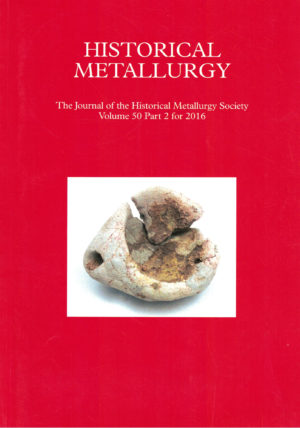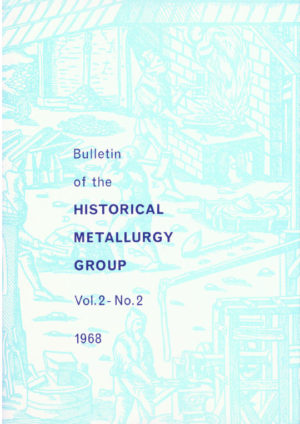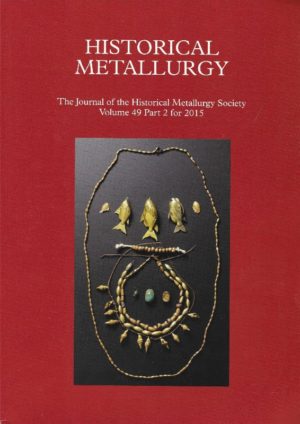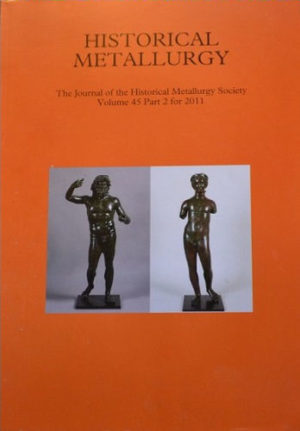Journal Contents
Metallographic examination of Iron Age tools from Somerset
Vanessa Fell
Pages 1-11
Nine files and three hammerheads were examined by metallography. The tools, all or most of which date to the later pre-Roman Iron Age, are from four different sites in Somerset: Glastonbury Lake Village, Meare Village East, Meare Village West, and Ham Hill. Carbon compositions were found to be generally low, though three tools comprised high-carbon steel in the areas examined. Six files and two hammerheads had been quenched. The results are compared with those from Iron Age tools examined previously from other sites in Britain.
Norwegian rosette-brooches of the 3rd century AD: their construction, materials and technique
Unn Plahter, Evabeth Astmp and Eldrid Straume
Pages 12-24
This study of Nonvegian rosette-brooches, dated to the 3rd century AD, siiows they were made of a range of metals. The intention always seems to have been to apply gold decoration, made with embossed gilded silver sheets with a pattern formed from beaded wire, to a ‘white’ object. The gilded silver sheet appears to have been made by two different methods, and the bow and spring were joined in two ways. The brooch springs were made of drawn silver wire, an occurrence of the technique several centuries earlier than has previously been noted.
Stable lead isotope characterization of various copper alloys used in West Africa: an interim report
E C Joel, E V Sayre, R D Vocke and F Willett
Pages 25-33
This is an interim report on a continuing project on the identification of the sources of copper alloys used in West Africa from the middle of the first millennium AD using the evidence offered by the varying isotopic composition of the lead in the alloys. Work so far has concentrated on samples we have in hand from Igbo Ukwu, Marandet, Ma’aden Ijafen, Ife, Benin City and Udo. This paper presents the groupings of lead isotopes in these various centres. There is very good separation between these casting centres which suggests that they obtained their metal from different sources. So far, whereas Igbo Ukwu and Ife each reveal two main sources, Benin, which we know from the historical documents traded with several different parts of Europe, shows one single source with very few outliers.
What happened to the pig that went to market - and to the steelmakers of Millom?
Robson Davies
Pages 34-45
Part 1 of this paper traces the causes of the demise of merchant pig iron production in Britain. Part 2 records features of the ironworks at The Millom Hematite Ore and Iron Co Ltd in Cumberland, including the Millspray pilot steelplant. Part 3 deals with the controversial dispute between the Company and the Iron and Steel Board (ISB) who opposed Millom’s plan to make steel.
'Trent sand': chalcopyrite as an abrasive
Martha Goodway and Michael A Constable
Pages 46-68
A loose abrasive until recently used in silversmithing in the Jewellery Quarter of Birmingham has been identified as ‘Trent sand’. Analysis showed that the chief component was chalcopyrite (CuFeSj), an important ore mineral of copper. Problems of misinterpretation of the activities represented by abrasives and the need to record all the materials of traditional industries are discussed.
Wrought and quenched, and cast high-tin bronzes in Kerala State, India
Sharada Srinivasan and Ian Glover
Pages 69-88
Binary high-tin bronze alloys have been recorded in SE Asian antiquity, and it had been reasonable to regard known Indian examples as imports from tin-rich SE Asia due to the scarcity of tin in India. However, this paper puts forth new evidence of ancient and surviving high-tin bronze working in the Indian subcontinent. It challenges the above assumption and indicates that the indigenous development of high-tin bronze working, and exploitation of the sparse tin deposits in ancient India, cannot be ruled out. Surviving traditions from Kerala in S India are documented of the manufacture of vessels and instruments of wrought and quenched high-tin bronze, and mirrors of cast high-tin bronze. New metallurgical evidence is presented for the continuous use of artefacts of high-tin bronze in the subcontinent from the 1st millennium BC to the present day, particularly in South India, which is corroborated by literary and iconographic evidence from the historical period.
Mail links from the de Soto entrada of 1540
Martha Goodway
Pages 89-93
Among 22 links recovered in Florida from Hernando de Soto’s expedition, four were of tin bronze and the remainder of iron. Most of the iron links were completely mineralized but sectioning revealed remnant areas of sound metal in eight links. The microstructures indicated that the links were fabricated from drawn wire by rivetting. There was no conclusive evidence that high phosphorus iron had been selected for the wire.
An experimental tin smelt at Flag Fen
Simon Timberlake
Pages 121-
Experimental bowl and shaft furnaces were constructed. Tin ore was smelted in the bowl furnace using bag bellows to supply the air. The process was relatively quick and simple to operate. Tin metal that was 99% pure was produced, with a yield of about 50%.
![[Test] The Historical Metallurgy Society](https://test.historicalmetallurgy.org/wp-content/uploads/2020/02/Logo120.png)





There are no reviews yet.